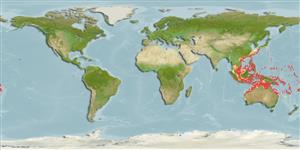Classification / Names
Common names from other countries
Main reference
Size / Weight / Age
Max length : 120 cm SL male/unsexed; (Ref. 6390); common length : 35.0 cm SL male/unsexed; (Ref. ); max. published weight: 23.6 kg (Ref. 6390); max. reported age: 26 years (Ref. 3639)
Length at first maturity
Lm ?, range 21 - 60 cm
Environment
Marine; reef-associated; depth range 3 - 100 m (Ref. 9710)
Climate / Range
Tropical; 24°C - ? (Ref. 2160), preferred ?; 35°N - 30°S, 99°E - 178°W (Ref. 5222)
Distribution
Western Pacific: from Western Australia, eastward to the Caroline Islands and Fiji: from southern Japan to Australia (Queensland); also recently recorded from Tonga (Ref. 53797). Often misidentified as Plectropomus maculatus.
Countries | FAO areas | Ecosystems | Occurrences | Introductions
Short description
Dorsal
spines
(total): 7 - 8;
Dorsal
soft rays
(total): 10-12;
Anal
spines: 3;
Anal
soft rays: 8. This species is distinguished by the following characters: D VIII,11; A III,8; pectoral rays 14-17 (modally 16); lateral line scales 89-99, in longitudinal series 112-127 scales; interorbital space no embedded scales; gill rakers on first gill arch developed 1-3 + 6-10; front of jaws with a pair of large canine teeth and side of lower jaw with 1-4 large canines; body elongate, its greatest depth 2.9-3.6 in SL; truncate to slightly emarginate caudal fin; pectoral fins 2.0-2.3 in HL; pelvic fins 2.0-2.4 in HL; Head, body and fins with numerous blue spots on red, pale grey or olive to dark brown background; caudal fin with a narrow white posterior margin except near the corners; juveniles (< 5 cm) brown on upper 2/3 of side with scattered blue spots, broad whitish stripe from eye to caudal fin base, white on lower head and yellowish ventrally on side (Ref. 4787, 54980, 90102).
IUCN Red List Status (Ref. 115185)
Threat to humans
Reports of ciguatera poisoning (Ref. 4821)
Human uses
Fisheries: commercial; aquaculture: commercial; gamefish: yes; aquarium: commercial
Tools
Special reports
Download XML
Internet sources
Estimates of some properties based on models
Phylogenetic diversity index
PD50 = 0.5078 many relatives (e.g. carps) 0.5 - 2.0 few relatives (e.g. lungfishes)
Trophic Level
4.4 ±0.7 se; Based on diet studies.
Resilience
Medium, minimum population doubling time 1.4 - 4.4 years (tm=2-4; tmax=26; Fec=457,900)
Vulnerability
Moderate to high vulnerability (51 of 100)
Price category
